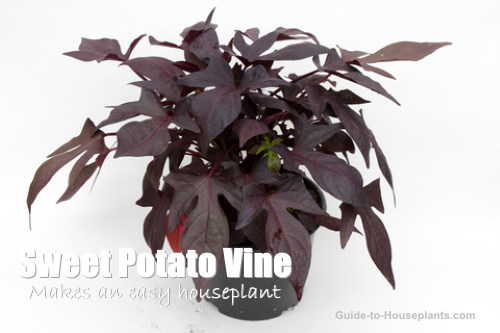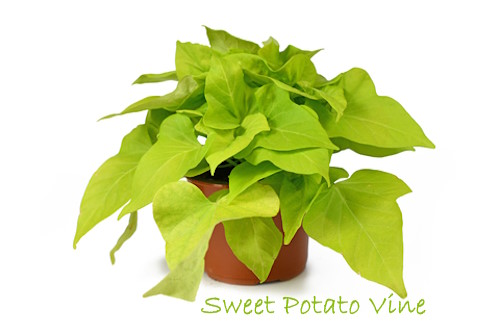How to Grow Sweet Potato Vine Indoors
Mounds of dense, colorful foliage make sweet potato vine a favorite ornamental. It's also fast-growing and practically care-free.
A favorite of Southern gardeners, sweet potato plants prefer moist, well-drained soil, warm temps and bright light. Give this easy-care ornamental vine what it wants and it'll reward you with three seasons of colorful foliage.

Get to Know Ornamental Sweet Potato Vine
Known botanically as Ipomoea batatas, this decorative sweet potato vine has origins in Central America.
Sweet potato leaves offer bold color from spring through fall. You don't need to overwinter -- treat this tender vine as an annual.
There is one draw-back with this vigorous vine...it has a tendency to take over any space available. It will crowd other plants if you let it.
How big does it get? It will grow up to 12 in (30 cm) tall, and will spread or trail several feet, if not cut back.
Don't be afraid to prune sweet potato vines back as much as needed to keep it under control. And don't throw away those cuttings, either. They'll root easily if you poke them into moist soil.
Wondering where to grow sweet potato plant?
Its trailing habit makes ornamental sweet potato vine ideal for a warm, sunny windowsill. Plant it in a hanging basket -- or a window box -- and let its lush vines spill over the side. Or use it as an underplanting for tall flowers outdoors.
Tie it to a trellis, if you want. Those long vines won't climb, so they need some help from you. Use florist ties to tie the weeping stems to a trellis or other support. A trellis makes a gorgeous backdrop for tall, upright plants in contrasting colors.
Varieties of Sweet Potato Vine
In addition to the garden-variety green foliage, you'll find an abundance of new cultivars with striking leaf shapes, in a stunning range of colors: lime green, golden yellow, coppery gold with a tinge of red, and rich, purplish-black. Popular cultivars include chartreuse 'Marguerite', dark-purple 'Blackie' and purple 'Sweet Caroline'.
Newer cultivars are cropping up with exciting color combinations. You'll want to seek beautiful tricolor 'Pink Frost' with eye-catching white and green leaves edged in pink.
How to Root Sweet Potato Vines Indoors
Propagating this plant is a cinch -- and a wonderful way to grow your collection.
Stem tip cuttings will dependably grow roots. Cut stem tips anytime during the growing season. Then, stick the cut ends in fresh, moist potting mix -- or put them in a glass of water. Keep the cuttings warm, watered and in bright, indirect sunlight. Sweet potato vines will root in about 2 to 3 weeks.
Something Eating Your Sweet Potato Vine?
Unfortunately, this easy-care decorative plant is a favorite of several destructive pests.
If your plant has spent any time outdoors, it may show nibbled edges or holes in its leaves. The most common insect is the golden tortoise beetle. Another bug that likes to eat leaves is the silverleaf whitefly, also known as the sweet potato whitefly.
Indoors, the most common sweet potato vine pest is aphids, which will suck plant juices from the vines.
Treat any infestation right away with an organic insecticide. If your plant is badly infested or damaged, get rid of it.
 Image © Monikabaumbach
Image © MonikabaumbachSweet Potato Vine Care Tips
Light: Moderate to bright light. Will tolerate some direct sunlight.
Water: Keep soil evenly moist at all times. This fast-growing vine is thirsty and dries out quickly in a container, so check it often. Use a container with drainage holes to prevent soggy soil which can lead to root rot.
Humidity: Try to maintain 40% relative humidity or higher. Brown leaf tips are a symptom of dry air. Indoor air can become extremely dry in winter. It's a good idea to use a humidity gauge near your tropical plants, rather than guess.
Temperature: Average to warm room temperatures (65-80°F/18-27°C). Wait till it's warm, if you move it outside; this tender vine doesn't like the cold and it won't tolerate frost.
Soil: All-purpose potting mix
Fertilizer: Feed monthly in spring, summer and fall with a balanced water-soluble fertilizer.


